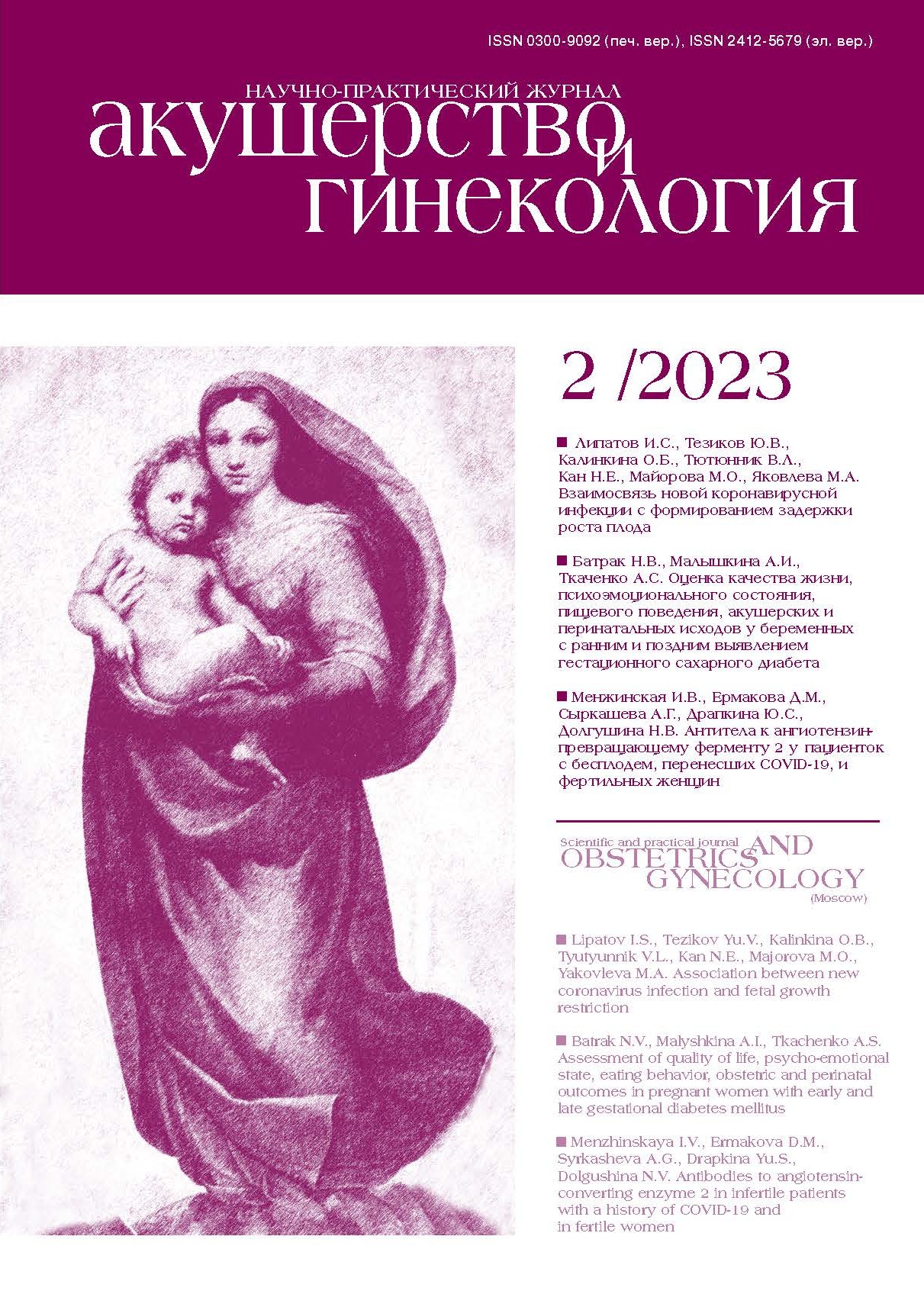Obstetric and neonatal outcomes of different management strategies in fetal macrosomia
- Authors: Tysyachnyi O.V.1, Baev O.R.1,2, Chausov A.A.1, Edilberg I.V.1, Gaidarova A.R.1
-
Affiliations:
- Academician V.I. Kulakov National Medical Research Center of Obstetrics, Gynecology and Perinatology, Ministry of Health of Russia
- I.M. Sechenov First Moscow State Medical University, Ministry of Health of Russia (Sechenov University)
- Issue: No 2 (2023)
- Pages: 46-52
- Section: Original Articles
- Published: 18.04.2023
- URL: https://journals.eco-vector.com/0300-9092/article/view/337581
- DOI: https://doi.org/10.18565/aig.2022.275
- ID: 337581
Cite item
Abstract
Fetal macrosomia is important to study given the high incidence of obstetric and neonatal complications. The induction of labor can reduce the incidence of adverse outcomes in complicated pregnancies. However, the effectiveness of labor induction in reducing the incidence of obstetric and neonatal complications in fetal macrosomia remains controversial.
Objective: To investigate obstetric and neonatal outcomes of different management strategies for fetal macrosomia (expectant management versus labor induction).
Materials and methods: This retrospective cohort study analyzed birth outcomes in 626 healthy primiparous women with fetal macrosomia. The patients were divided into a study group (n=334) with labor induction and a control group (n=295) with expectant management. Each group was divided into gestational age subgroups 1, 2, 3, and 4 of 37–38, 39, 40, and 41 weeks, respectively.
Results: The caesarean section rate for induction of labor at 37-39 weeks was not different from that in the expectant management group, whereas it was significantly higher at 40 weeks (p=0.02). However, at 41 weeks, the situation changed, and the rate of caesarean sections was significantly higher in the expectant management group (p=0.04). There were no differences in the rates of vaginal delivery, fetal shoulder dystocia, or perinatal outcomes.
Conclusion: With the development of fetal macrosomia, it is too late to count on the effectiveness of labor induction, which is the traditional approach to preventing complications. Preventing macrosomia and developing other approaches to prevent its adverse consequences are important.
Full Text
About the authors
Oleg V. Tysyachnyi
Academician V.I. Kulakov National Medical Research Center of Obstetrics, Gynecology and Perinatology, Ministry of Health of Russia
Author for correspondence.
Email: o_tysyachny@oparina4.ru
ORCID iD: 0000-0001-9282-9817
PhD, Junior Researcher at the 1st Maternity Department
Russian Federation, MoscowOleg R. Baev
Academician V.I. Kulakov National Medical Research Center of Obstetrics, Gynecology and Perinatology, Ministry of Health of Russia; I.M. Sechenov First Moscow State Medical University, Ministry of Health of Russia (Sechenov University)
Email: o_baev@oparina4.ru
ORCID iD: 0000-0001-8572-1971
Dr. Med. Sci., Head of the Maternity Department; Professor at the Department of Obstetrics, Gynecology, Perinatology, and Reproductology
Russian Federation, Moscow; MoscowAndrey A. Chausov
Academician V.I. Kulakov National Medical Research Center of Obstetrics, Gynecology and Perinatology, Ministry of Health of Russia
Email: a_chausov@oparina4.ru
ORCID iD: 0000-0002-3094-7209
Head of the Information and Analytical Center of the Department of Regional Cooperation and Integration
Russian Federation, MoscowIrina V. Edilberg
Academician V.I. Kulakov National Medical Research Center of Obstetrics, Gynecology and Perinatology, Ministry of Health of Russia
Email: i_edilberg@oparina4.ru
ORCID iD: 0000-0003-4194-8730
PhD Student
Russian Federation, MoscowAsiyat R. Gaidarova
Academician V.I. Kulakov National Medical Research Center of Obstetrics, Gynecology and Perinatology, Ministry of Health of Russia
Email: a_gadzhieva@oparina4.ru
ORCID iD: 0000-0003-1415-3318
PhD Student
Russian Federation, MoscowReferences
- Salihu H.M., Dongarwar D., King L.M., Yusuf K.K., Ibrahimi S., Salinas-Miranda A.A. Trends in the incidence of fetal macrosomia and its phenotypes in the United States, 1971-2017. Arch. Gynecol. Obstet. 2020; 301(2): 415-26. https://dx.doi.org/10.1007/s00404-019-05400-9.
- Henriksen T. The macrosomic fetus: a challenge in current obstetrics. Acta Obstet. Gynecol. Scand. 2008; 87(2): 134-45. https://dx.doi.org/ 10.1080/00016340801899289.
- Moldéus K., Cheng Y.W., Wikström A.-K., Stephansson O. Induction of labor versus expectant management of large-for-gestational-age infants in nulliparous women. PLoS One. 2017; 12(7): e0180748. https://dx.doi.org/10.1371/ journal.pone.0180748.
- Nikiforovskiĭ N.K., Pokusaeva V.N., Stas' L.I., Gul'chenko O.V. Obstetric and perinatal outcomes in a large fetus. Russian Bulletin of Obstetrician-Gynecologist. 2010; 10(1): 55 8. (in Russian).
- Beta J., Khan N., Khalil A., Fiolna M., Ramadan G., Akolekar R. Maternal and neonatal complications of fetal macrosomia: systematic review and meta‐analysis. Ultrasound Obstet. Gynecol. 2019; 54(3): 308-18. https://dx.doi.org/10.1002/uog.20279.
- Aviram A., Yogev Y., Ashwal E., Hiersch L., Danon D., Hadar E. et al. Different formulas, different thresholds and different performance—the prediction of macrosomia by ultrasound. J. Perinatol. 2017; 37(12): 1285-91. https://dx.doi.org/10.1038/jp.2017.134.
- Boulvain M., Irion O., Thornton J.G. Induction of labour at or near term for suspected fetal macrosomia. Cochrane Database Syst. Rev. 2016; 2022(8): CD000938. https://dx.doi.org/10.1002/14651858.CD000938.pub2.
- Bayeva I.Yu. Clinical significance of prenatal diagnosis of macrosomia by ultrasound. Journal of Obstetrics and Women's Diseases. 2014; 63(3): 12-20. (in Russian).
- Knight M., Chiocchia V., Partlett C., Rivero-Arias O., Hua X., Hinshaw K. et al. Prophylactic antibiotics in the prevention of infection after operative vaginal delivery (ANODE): a multicentre randomised controlled trial. Lancet. 2019; 393(10189): 2395-403. https://dx.doi.org/10.1016/S0140-6736(19)30773-1.
- Cluver C., Novikova N., Koopmans C.M., West H.M. Planned early delivery versus expectant management for hypertensive disorders from 34 weeks gestation to term. Cochrane Database Syst. Rev. 2017; 1(1): CD009273. https://dx.doi.org/10.1002/14651858.CD009273.
- Wood A.M., Livingston E.G., Hughes B.L., Kuller J.A. Intrahepatic cholestasis of pregnancy: a review of diagnosis and management. Obstet. Gynecol. Surv. 2018; 73(2): 103-9. https://dx.doi.org/10.1097/OGX.0000000000000524.
- Sorokina A.V. A large fetus: myths and realities. Russian Bulletin of Obstetrician-Gynecologist. 2013; 13(4): 86 8. (in Russian).
- Russian Society of Obstetricians and Gynecologists. Clinical guidelines "Failed attempt at labor stimulation (cervical preparation and labor induction)". 2021. (in Russian). Available at: https://roag-portal.ru/recommendations_obstetrics
- Odinokova V.A., Shmakov R.G. Birth outcomes in primiparous women diagnosed with fetal macrosomia and managed with active surveillance and watch-and-wait approach. Obstetrics and Gynecology. 2022; (1): 72-9. (in Russian).
- Vitner D., Bleicher I., Kadour-Peero E., Borenstein-Levin L., Kugelman A., Sagi S. et al. Induction of labor versus expectant management among women with macrosomic neonates: a retrospective study. J. Matern. Neonatal Med. 2020; 33(11): 1831-9. https://dx.doi.org/10.1080/14767058.2018.1531121.
- Boulvain M., Senat M.-V., Perrotin F., Winer N., Beucher G., Subtil D. et al. Induction of labour versus expectant management for large-for-date fetuses: a randomised controlled trial. Lancet. 2015; 385(9987): 2600-5. https://dx.doi.org/10.1016/S0140-6736(14)61904-8.
Supplementary files










